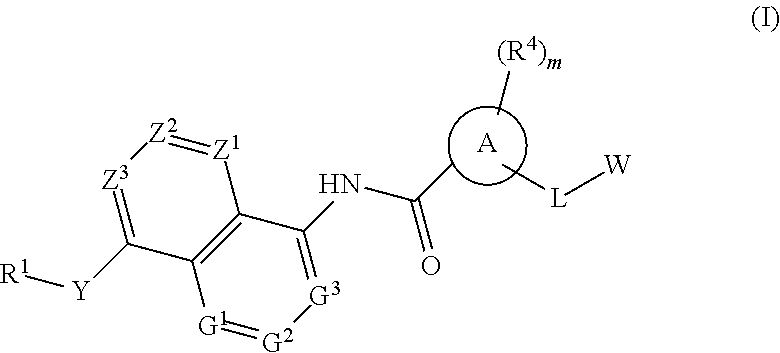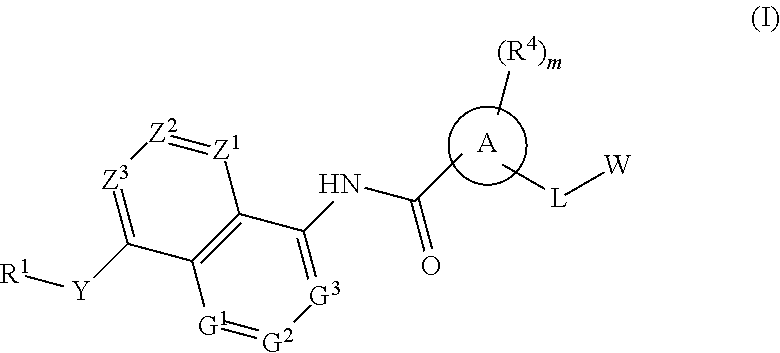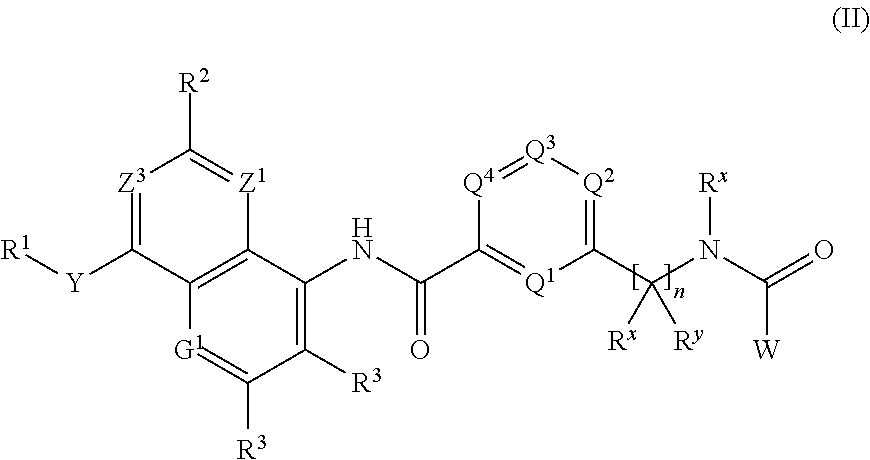BICYCLIC COMPOUNDS AS mPGES-1 INHIBITORS
a technology of mpges-1 inhibitors and bicyclic compounds, which is applied in the field of bicyclic compounds, can solve the problems of insufficient efficacy and/or the prevalence of side effects, inflammation is also a common cause of pain, and reduces the beneficial properties of some metabolites
- Summary
- Abstract
- Description
- Claims
- Application Information
AI Technical Summary
Benefits of technology
Problems solved by technology
Method used
Image
Examples
example-1
6-Chloro-2-fluoro-3-(pivalamidomethyl)-N-(1-((3-(trifluoromethyl)phenyl)amino)isoquinolin-5-yl)benzamide
[0571]
[0572]To a solution of 6-chloro-2-fluoro-3-(pivalamidomethyl)benzoic acid (Intermediate-2, 190 mg, 0.66 mmol) in CH2Cl2 (4.0 mL) was added oxalyl chloride (153 mg, 1.22 mmol) and DMF (1 drop). The reaction mass was stirred at rt for 2 h before it was concentrated. The concentrate was dissolved in CH2Cl2 (1 mL) and was added to a solution of N′-(3-(trifluoromethyl)phenyl)isoquinoline-1,5-diamine (Intermediate-1, 100 mg, 0.33 mmol) in CH2Cl2 (2 mL) and DIPEA (1.0 mL) at 0° C. The reaction mass was stirred at rt for 2 h before it was quenched with water and was extracted with chloroform. The organic layer was separated, dried, filtered, and concentrated.
[0573]The residue was purified by column chromatography to afford 25 mg of the title product. 1H NMR (300 MHz, DMSO-d6): δ 10.90 (s, 1H), 9.56 (s, 1H), 8.49 (d, J=8.4 Hz, 1H), 8.35 (s, 1H), 8.23-8.21 (m, 2H), 8.12 (d, J=6.3 Hz, ...
example-2
3-Chloro-6-(pivalamidomethyl)-N-(1-((3-(trifluoromethyl)phenyl)amino)isoquinolin-5-yl)picolinamide
[0574]
[0575]The title compound was prepared following the procedure described in Example-1 using N′-(3-(trifluoromethyl)phenyl)isoquinoline-1,5-diamine (Intermediate-1, 70 mg, 0.23 mmol), 3-chloro-6-(pivalamidomethyl)picolinic acid (Intermediate-3, 121 mg, 0.45 mmol), oxalyl chloride (85 mg, 0.68 mmol), DMF (1 drop) and DIPEA (89 mg, 0.69 mmol) in CH2Cl2 (3 mL) to afford 15 mg of the title product. 1H NMR (300 MHz, DMSO-d6): δ 10.78 (s, 1H), 9.56 (s, 1H), 8.48 (d, J=8.1 Hz, 1H), 8.36-8.22 (m, 3H), 8.12-8.03 (m, 3H), 7.71 (t, J=8.4 Hz, 1H), 7.56 (t, J=7.8 Hz, 1H), 7.44-7.38 (m, 2H), 7.31 (d, J=7.8 Hz, 1H), 4.44 (d, J=5.7 Hz, 2H), 1.17 (s, 9H); MS (m / z): 556.12 (M+H)+.
example-3
2,6-Dimethyl-3-(pivalamidomethyl)-N-(1-((3-(trifluoromethyl)phenyl)amino)isoquinolin-5-yl)benzamide
[0576]
[0577]The title compound was prepared following the procedure described in Example-1 using N′-(3-(trifluoromethyl)phenyl)isoquinoline-1,5-diamine (Intermediate-1, 70 mg, 0.23 mmol), 2,6-dimethyl-3-(pivalamidomethyl)benzoic acid (Intermediate-4, 120 mg, 0.45 mmol), oxalyl chloride (85 mg, 0.68 mmol), DMF (1 drop) and DIPEA (89 mg, 0.69 mmol) in CH2Cl2 (3 mL) to afford 10 mg of the title product. 1H NMR (300 MHz, DMSO-d6): δ 10.51 (s, 1H), 9.51 (s, 1H), 8.44 (d, 1H), 8.31 (s, 1H), 8.22 (d, 1H), 8.08 (d, 1H), 7.97 (m, 1H), 7.69 (m, 1H), 7.53 (m, 2H), 7.37 (d, 1H), 7.30 (d, 1H), 7.11 (s, 2H), 4.24 (d, 2H), 2.36 (s, 3H), 2.32 (s, 3H), 1.14 (s, 9H); MS [M+H]+: 549.15.
PUM
| Property | Measurement | Unit |
|---|---|---|
| temperature | aaaaa | aaaaa |
| temperature | aaaaa | aaaaa |
| temperature | aaaaa | aaaaa |
Abstract
Description
Claims
Application Information
 Login to View More
Login to View More - R&D
- Intellectual Property
- Life Sciences
- Materials
- Tech Scout
- Unparalleled Data Quality
- Higher Quality Content
- 60% Fewer Hallucinations
Browse by: Latest US Patents, China's latest patents, Technical Efficacy Thesaurus, Application Domain, Technology Topic, Popular Technical Reports.
© 2025 PatSnap. All rights reserved.Legal|Privacy policy|Modern Slavery Act Transparency Statement|Sitemap|About US| Contact US: help@patsnap.com



